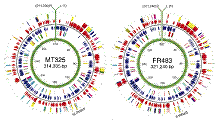Virology, Nebraska Center for
Document Type
Article
Date of this Version
2005
Abstract
Objectives: To determine the genetic and phenotypic composition of HIV-1 found in the choroid plexus (CPx) and its relationship to virus in the brain and peripheral lymphoid tissue. Design: Phenotypic and molecular comparisons of HIV-1 found in autopsy brain, CPx, and spleen tissues. Methods: HIV-1 was co-cultured from matched postmortem brain (basal ganglia), CPx, and spleen tissues of AIDS patients with and without HIV-associated encephalitis and dementia. Viral phenotypes were determined by infection of monocyte-derived macrophages, MT-2 or co-receptor-specific cell lines. Viral env and pol sequences were determined from genomic DNA isolated directly from tissues or co-cultures, and phylogenetic comparisons were performed. Results: CCR5-utilization was the most prevalent viral tropism found in all tissues, although spleen isolates also displayed CXCR4 usage. Viruses isolated from CPx consisted of both peripheral and brain-like virus, but were more related phenotypically and genetically to those found in the brain. Mutations found in the pol gene that could confer drug resistance to brain and CPx isolates were similar to those found in the periphery. Conclusion: The CPx contained replication-competent virus that was most similar, although distinct, from that found in the brain. It also contained some viruses with high similarity to those of peripheral origin. Compartmentalization of viral env and pol sequences indicated that differential selective pressures exist in each tissue examined. These studies suggest that the CPx may provide an environment that promotes the evolution of drug-resistant strains with central nervous system tropism, although it is unlikely to be a reservoir for archival HIV-1 variants.



Comments
Originally published in AIDS 19 (2005): 675-684. AIDS online Copyright 2005 by Lippincott, Williams & Wilkins. Used by permission.